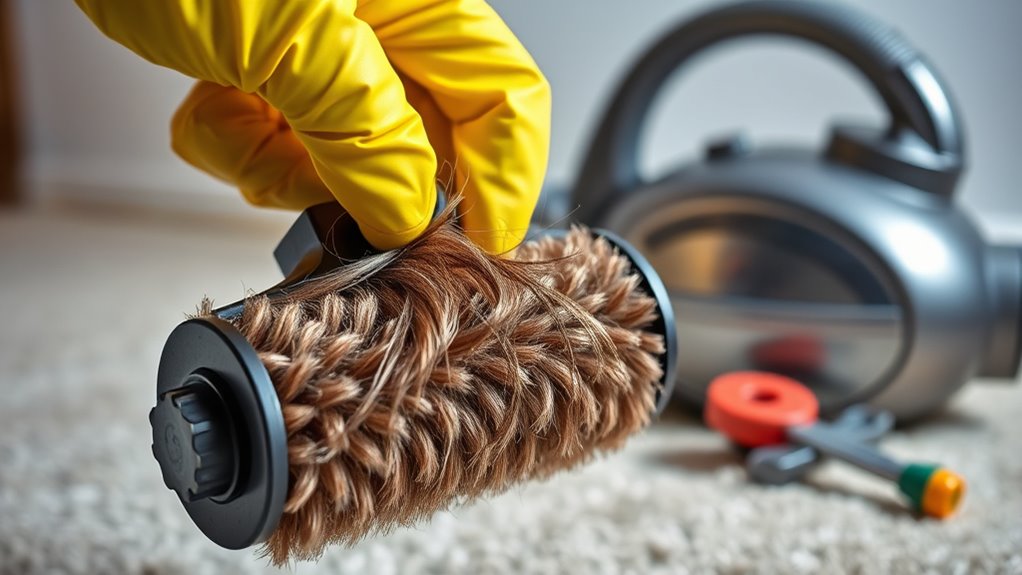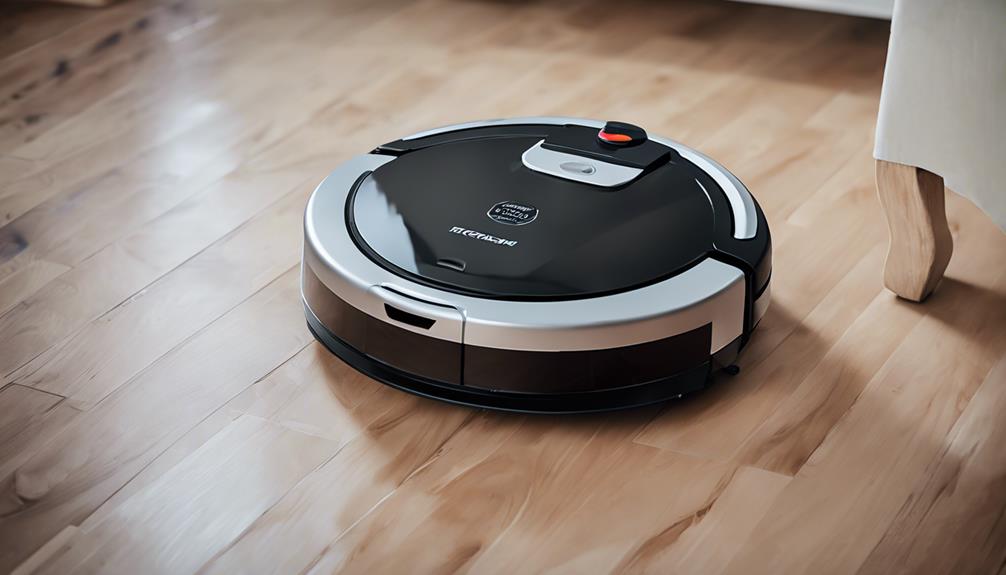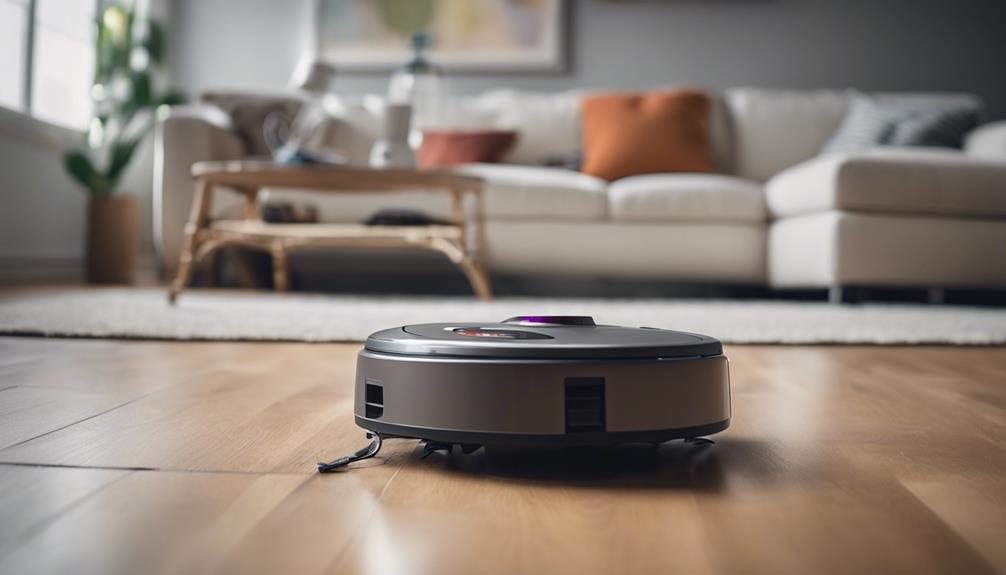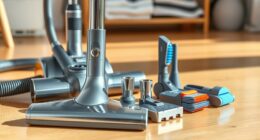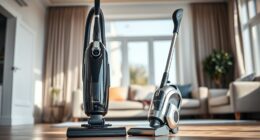To prevent your vacuum roller brush from burning out, start by cleaning it regularly to remove tangled hair and debris. Proper lubrication is key; use silicone lubricant to reduce friction. Keep an eye on your vacuum usage and avoid overworking it. Monitor performance signs like unusual noises and reduced suction. Finally, replace worn parts promptly to maintain efficiency. Follow these tips closely, and you’ll discover even more strategies to extend your vacuum’s lifespan.
Key Takeaways
- Regularly clean the roller brush to remove hair and debris, ideally once a month, to prevent overheating and friction.
- Lubricate the roller brush with silicone lubricants to reduce friction, extend lifespan, and enhance performance.
- Monitor vacuum usage; avoid excessive operation to minimize wear on components and prevent burnout.
- Conduct frequent performance checks for unusual noises or reduced suction, indicating potential issues with the roller brush.
- Replace worn parts promptly, including the brush roller and belt, to maintain optimal vacuum efficiency and prevent further damage.
Regular Cleaning of the Roller Brush

To keep your vacuum running smoothly, regular cleaning of the roller brush is essential.
Start by preparing a clean workspace with good lighting, then disassemble the vacuum to access the brush roller. Depending on your model, remove screws or clips.
Next, use fine scissors or a seam ripper to carefully cut away any tangled hair. To clean the brush, mix water and vinegar or a mild detergent, scrubbing with a cleaning brush or toothbrush to remove stubborn dirt. Regularly check to ensure the vacuum brush is functioning optimally by removing hair and debris. Keeping the brush clean also supports better filtration and overall vacuum performance. Additionally, maintaining a clean roller brush can enhance suction power, which is crucial for effective cleaning performance. Effective maintenance can improve toilet functionality by ensuring that all mechanisms operate efficiently without obstruction. Additionally, maintaining your vacuum can lead to energy savings by reducing the power needed for effective cleaning.
Rinse thoroughly with clean water to eliminate any residue. Aim for monthly cleanings or more frequently if you use your vacuum often.
This simple maintenance will enhance suction, prevent blockages, and extend the brush’s lifespan, ensuring peak performance.
Importance of Proper Lubrication
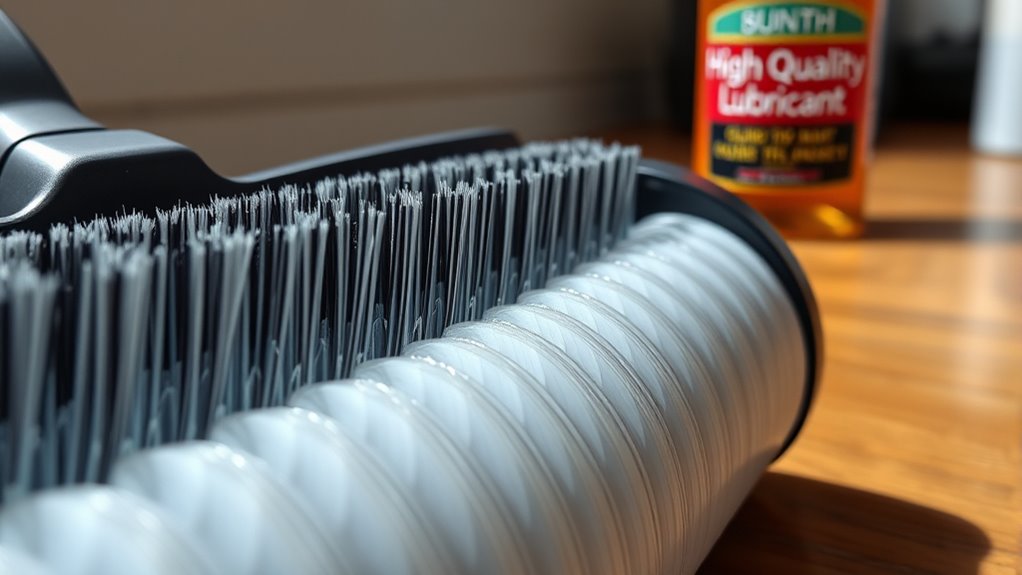
Proper lubrication is essential for maintaining your vacuum’s roller brush, as it not only extends its lifespan but also enhances overall performance. Using silicone lubricants is ideal, as they won’t attract dirt like oil or grease. Freshly squeezed juice retains more nutrients than processed juice, making it a good analogy for the importance of maintaining your vacuum’s components. Proper lubrication reduces friction between moving parts, preventing overheating and burnout, while also protecting the bristles from wear. Additionally, using a lubrication brush can ensure even and precise lubricant distribution, which is crucial for optimal performance. Regularly maintaining your vacuum can help prevent buildup of dirt and grime, which can lead to further issues. To maximize efficiency, consider color accuracy in your vacuum’s design, as it can influence the effectiveness of its cleaning performance. Moreover, maintaining the correct lubrication level can improve the overall energy efficiency of the vacuum, allowing it to perform better while consuming less power. Make certain the lubricant is compatible with your roller brush materials and suitable for your operating environment. Air purifiers can help maintain a cleaner environment, reducing dust accumulation around your vacuum. Apply the right amount—over-lubrication can attract dust, while under-lubrication increases wear. Regular checks on lubrication levels keep your vacuum running smoothly and quietly, improving efficiency and saving you money on replacements. Prioritize proper lubrication to make sure your vacuum brush operates at its best.
Managing Vacuum Usage

While you might be tempted to use your vacuum frequently, managing its usage is key to preventing roller brush burnout.
Regularly clean the roller brush to remove hair and debris that can cause friction. A buildup of hair can hinder the roller brush’s rotation and cleaning ability, so avoid overusing the vacuum, as excessive usage can wear down components faster. It’s also important to monitor air quality indicators in your home, as poor air quality can lead to more frequent vacuuming. Using a vacuum with HEPA filters can help improve your home’s air quality and potentially reduce cleaning frequency. Additionally, ensuring that your vacuum is equipped with effective filtration systems can enhance its performance and longevity. Proper airflow management is critical to maintaining the vacuum’s efficiency and preventing overheating. A vacuum with high suction power can also contribute to better cleaning results with less effort.
Store your vacuum in a dry, cool place to protect it from moisture. Check for blockages in tubes and filters to guarantee proper airflow; restricted airflow puts extra strain on the roller brush.
Establish a maintenance schedule that includes cleaning and inspecting the roller brush regularly.
Monitoring Performance for Early Signs

Monitoring your vacuum’s performance is essential for catching early signs of brush burnout. Keep an eye on the brush speed, which should ideally be between 3000 to 4500 RPM for peak cleaning.
Pay attention to airflow and suction, as these factors often matter more than brush speed. Regularly check for debris accumulation around the brush, since blockages can impair performance. Implementing regular maintenance can further enhance the vacuum’s efficiency and prolong its lifespan. Additionally, maintaining air quality in your home can prevent dust and allergens from clogging the vacuum’s components. Studies show that effective filtration, such as HEPA filters, can reduce airborne pollutants that may contribute to vacuum clogs. In addition, understanding the efficiency ratings of your vacuum can help you choose a model that minimizes wear and tear.
Listen for unusual noises, as they may indicate wear or clogs. If you notice reduced suction or visible debris, it could signal brushroll issues.
Remember, the material and condition of the bristles impact cleaning efficiency, so inspect them regularly. Additionally, home security systems with integrated monitoring can alert you to performance issues before they escalate.
Timely Replacement of Worn Parts
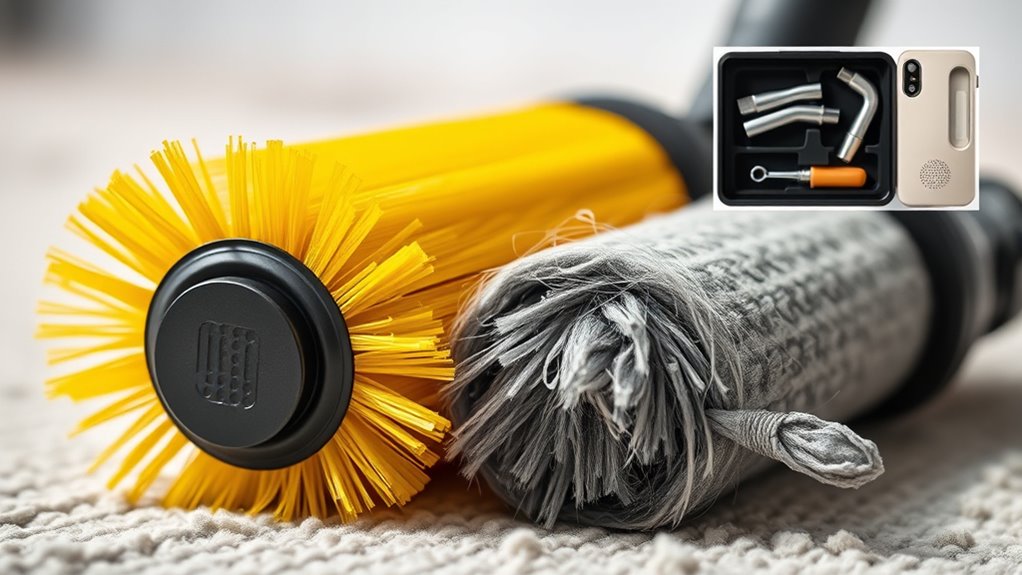
To keep your vacuum running smoothly, you need to identify worn components and replace them promptly. Scheduling regular replacements helps maintain efficiency and prevents further damage. Always opt for quality replacement parts to guarantee your vacuum performs at its best. Regular maintenance may require brush roll replacement to ensure optimal performance. Additionally, consider the potential for water conservation when selecting a vacuum, as efficient designs can contribute to reduced resource usage. Understanding Software Development Life Cycle (SDLC) can also enhance the overall maintenance process by ensuring that all components are up to industry standards. Regularly replacing worn parts can help prevent vacuum roller brush burnout, ensuring your vacuum continues to perform effectively.
Identify Worn Components
Identifying worn components is essential for maintaining your vacuum’s performance and preventing brush burnout. You should regularly check for signs of wear that could impact efficiency. Here are three key indicators to watch for:
- Bristle Condition: If the bristles are frayed, bent, or worn down, it’s time to replace them.
- Noise Increase: Excessive noise during operation may signal worn bearings or misaligned parts that need attention.
- Reduced Performance: If your vacuum struggles to pick up dirt effectively, a worn-out brush roll could be the culprit. It is important to select the correct brush roll for your vacuum model to ensure optimal performance.
Schedule Regular Replacements
Regularly scheduling replacements for worn parts is essential to keeping your vacuum running smoothly and efficiently. Here’s a quick guide to help you manage your replacement schedule effectively:
| Part | Replacement Frequency | Signs of Wear |
|---|---|---|
| Vacuum Bag | When two-thirds full | Reduced suction power |
| Belt | Every 6 to 12 months | Stretching or cracking |
| Brush Roller | Every 6 to 12 months | Worn bristles |
Make sure to inspect these parts regularly. If you notice any signs of wear, don’t hesitate to replace them. Timely replacements not only enhance cleaning performance but also prevent motor strain, ultimately extending your vacuum’s lifespan. Additionally, regular maintenance ensures that your vacuum operates efficiently and contributes to a healthier home environment. Keep your vacuum in top shape, and it’ll serve you well!
Use Quality Replacement Parts
Using quality replacement parts is essential for maintaining your vacuum’s performance and longevity. When you choose high-quality components, you not only guarantee compatibility but also enhance efficiency and durability.
Here are three key factors to take into account:
- Material Quality: Opt for parts made from durable materials that withstand wear and tear, improving the brush roller’s lifespan.
- Design Features: Look for adjustable bristles or specialized surfaces tailored for different floor types, boosting cleaning performance. Additionally, consider using compatible brush strips from older models as potential replacements.
- Brand Reputation: Select parts from reputable brands, guaranteeing reliability and access to customer support or warranties if needed.
Addressing Causes of Burnout
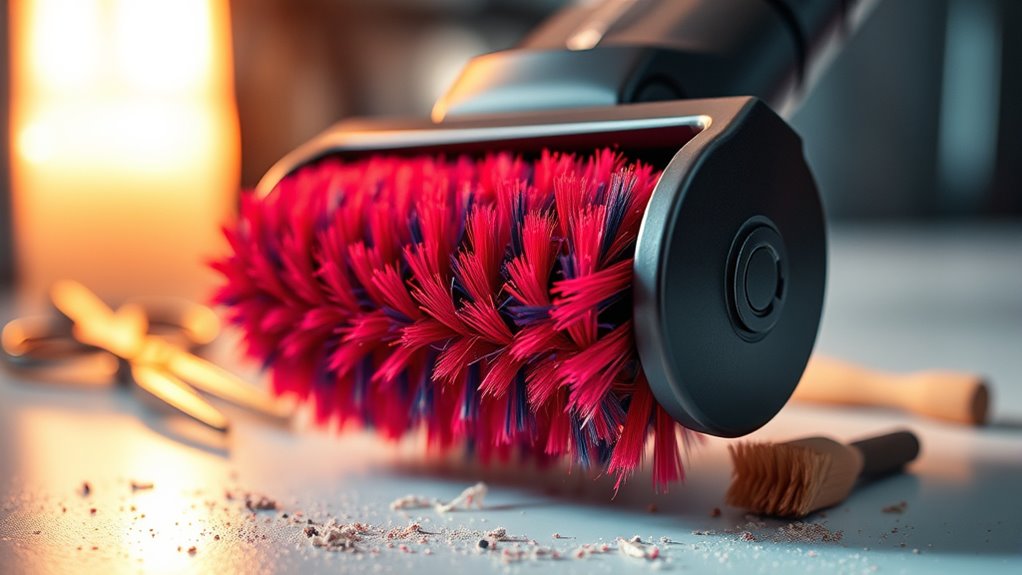
To prevent vacuum brush burnout, you need to focus on hair accumulation and proper lubrication. Regularly checking for hair wrapped around the roller will keep friction low and performance high. Additionally, using the right lubrication techniques can enhance the efficiency and lifespan of your vacuum’s components. Furthermore, addressing the design flaw in your roller brush can prevent premature wear and improve overall functionality.
Hair Accumulation Prevention
While you mightn’t think much about hair accumulation, it can greatly impact your vacuum’s performance. Hair entanglement reduces suction power and can even damage the motor due to added stress.
To keep your vacuum running smoothly, consider these prevention techniques:
- Use a rubber squeegee broom before vacuuming to minimize hair entanglement.
- Invest in a tangle-free vacuum with features like Hoover’s ANTI-TWIST technology for continuous hair removal.
- Implement a regular cleaning schedule to inspect and clean the brush roll, removing any stuck hair.
Proper Lubrication Techniques
Proper lubrication techniques are essential for maintaining your vacuum’s performance and preventing brush burnout. By reducing friction and heat buildup, proper lubrication considerably extends the life of your roller brushes. You should regularly check lubricant levels and apply the right type based on your vacuum’s needs. Here’s a quick guide on lubrication methods:
| Lubrication Method | Description |
|---|---|
| Manual Application | Targeted application, requires regular checks |
| Drip Lubrication | Continuous oil supply for low-pressure systems |
| Oil Bath Lubrication | Thorough lubrication in a sealed environment |
| Oil-Ring Lubrication | Distributes oil using centrifugal force |
| Force-Feed Lubrication | Continuous cooling and lubrication for high demand |
Ensuring proper lubrication not only helps to prevent brush burnout but also maximizes the efficiency of your vacuum’s operation. Make sure to perform daily checks and schedule annual servicing to keep everything running smoothly.
Essential Maintenance Tips
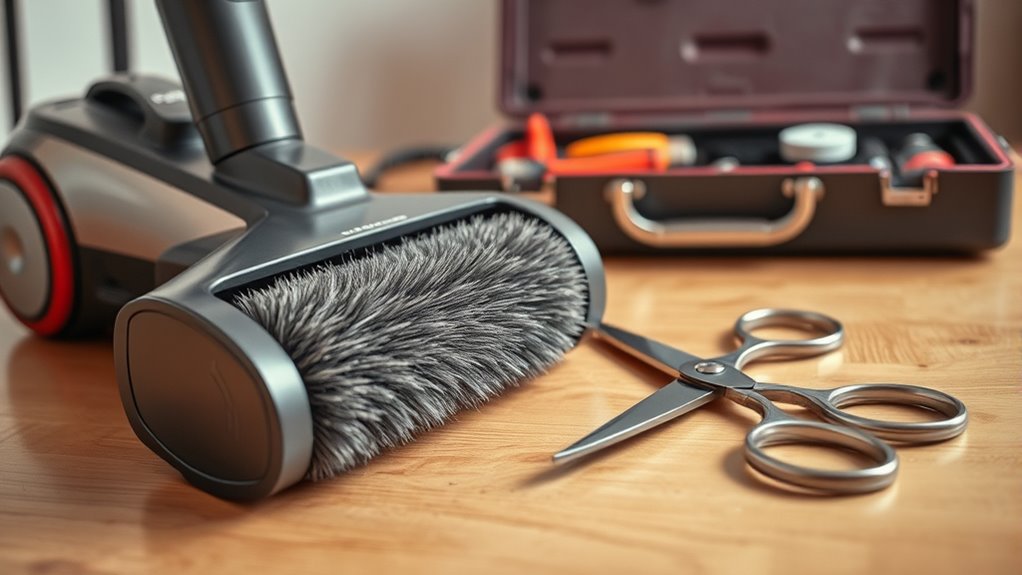
Keeping your vacuum brush in top shape is essential for maintaining its performance and longevity. Regular maintenance can prevent burnout and guarantee efficient operation.
Maintaining your vacuum brush is crucial for optimal performance and longevity, ensuring efficient operation and preventing burnout.
Here are three essential tips to follow:
- Regular Inspection: Check the roller brush monthly for wear or debris. This helps catch potential issues early. Additionally, regular cleaning prevents debris buildup and maintains suction.
- Cleaning Frequency: Clean the roller brush at least once a month. Removing hair and debris prevents buildup that can hinder performance.
- Tool Selection: Use scissors or seam rippers to carefully remove tangled hair and debris. Always unplug the vacuum before starting maintenance to avoid accidents.
Advanced Repair Techniques for Roller Brushes
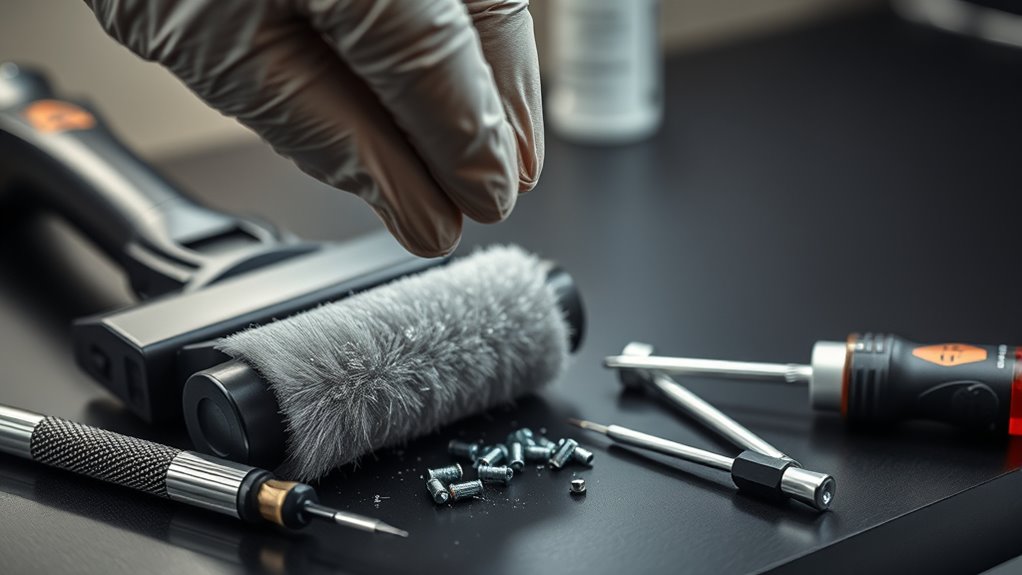
Regular maintenance lays the groundwork for effective vacuum brush performance, but when issues arise, advanced repair techniques can save the day.
Start by identifying design flaws like short splines that might lead to future failures. You can enhance durability by modifying the roller brush for better spline contact. Use epoxy and metal pins for repairs, and sandblast the shaft to guarantee a strong bond.
Employ specialized tools, like needle files for creating grooves or tin snips for precise cuts. Regularly inspect for wear and debris buildup, as friction from dirt can cause damage. Additionally, ensure the rubber belt is tight and undamaged to maintain optimal brush rotation.
If DIY efforts fall short, seek professional evaluation to replace worn parts and guarantee proper alignment, keeping your vacuum brush running smoothly.
Frequently Asked Questions
How Often Should I Clean My Vacuum’s Roller Brush?
You should clean your vacuum’s roller brush at least once a month, especially if you notice hair tangles or diminished suction.
If you use your vacuum frequently or on carpets, consider cleaning it more often.
Look for signs like hair buildup or unusual odors, which indicate it’s time for a cleaning.
Regular maintenance not only keeps your vacuum running efficiently but also extends its lifespan and improves indoor air quality.
What Type of Lubricant Is Best for Roller Brush Bearings?
When choosing a lubricant for roller brush bearings, consider mineral oils for affordability and effectiveness, synthetic oils for superior performance in varying temperatures, or grease for hard-to-reach areas.
You’ll also find dry lubricants useful in high-temperature situations.
Remember, the right lubricant reduces friction, protects against corrosion, and maintains performance.
Regularly check for compatibility with your bearings and reapply as necessary to keep everything running smoothly.
Can I Use My Vacuum on All Floor Types?
Yes, you can use your vacuum on all floor types, but it’s important to adjust settings accordingly.
For hardwood, switch to soft bristle brushes and lower suction.
On tile, use high suction and edge-cleaning features for grout.
For carpets, make certain you’ve got strong suction and motorized brush rolls.
If you have mixed flooring, look for vacuums with dynamic suction adjustment and versatile brush designs to guarantee effective cleaning without damage.
How Do I Know if My Vacuum’s Belt Is Installed Correctly?
To know if your vacuum’s belt is installed correctly, check for proper tension; it should be snug, allowing the brush roll to spin freely.
Confirm the belt aligns with the motor shaft and brush roll without slipping. Listen for unusual noises during operation, and watch out for a burning smell or reduced suction.
Regularly inspect the belt for wear, and make certain it’s seated correctly in its grooves to prevent issues.
What Are the Signs of a Damaged Roller Brush?
Did you know that nearly 30% of vacuum issues stem from a damaged roller brush?
If your vacuum’s performance dips, check for visible damage like cracks, or listen for unusual grinding noises. You might notice overheating, or the brush failing to spin.
If it’s picking up less dirt, that’s another red flag. Regular inspections can help you catch these signs early, ensuring your vacuum runs efficiently and extends its lifespan.
Conclusion
By following these tips, you can keep your vacuum roller brush running like a dream! Regular cleaning, proper lubrication, and mindful usage are key to preventing burnout. Don’t wait for warning signs; monitor performance and replace worn parts promptly. Addressing the causes of burnout head-on will save you from the headache of costly repairs. With a little care, your roller brush can outlast the Energizer Bunny, keeping your vacuum efficient and your home spotless!
